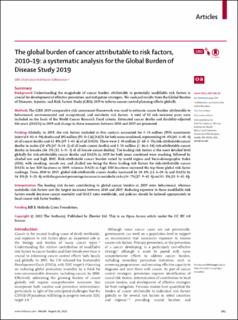| dc.contributor.author | Tran, Khanh Bao | |
| dc.contributor.author | Lang, Justin J. | |
| dc.contributor.author | Compton, Kelly | |
| dc.contributor.author | Kisa, Adnan | |
| dc.contributor.author | Xu, Rixing | |
| dc.contributor.author | Acheson, Alistair R | |
| dc.contributor.author | Henrikson, Hannah Jacqueline | |
| dc.contributor.author | Kocarnik, Jonathan M. | |
| dc.contributor.author | Kisa, Sezer | |
| dc.contributor.author | Penberthy, Louise | |
| dc.contributor.author | Risk Factors Collaborators, GBD 2019 Cancer | |
| dc.date.accessioned | 2022-10-06T09:12:19Z | |
| dc.date.available | 2022-10-06T09:12:19Z | |
| dc.date.created | 2022-08-19T17:08:07Z | |
| dc.date.issued | 2022-08-18 | |
| dc.identifier.citation | The Lancet. 2022, . | en_US |
| dc.identifier.issn | 0140-6736 | |
| dc.identifier.issn | 1474-547X | |
| dc.identifier.uri | https://hdl.handle.net/11250/3024238 | |
| dc.description.abstract | Background: Understanding the magnitude of cancer burden attributable to potentially modifiable risk factors is crucial for development of effective prevention and mitigation strategies. We analysed results from the Global Burden of Diseases, Injuries, and Risk Factors Study (GBD) 2019 to inform cancer control planning efforts globally.
Methods: The GBD 2019 comparative risk assessment framework was used to estimate cancer burden attributable to behavioural, environmental and occupational, and metabolic risk factors. A total of 82 risk–outcome pairs were included on the basis of the World Cancer Research Fund criteria. Estimated cancer deaths and disability-adjusted life-years (DALYs) in 2019 and change in these measures between 2010 and 2019 are presented.
Findings: Globally, in 2019, the risk factors included in this analysis accounted for 4·45 million (95% uncertainty interval 4·01–4·94) deaths and 105 million (95·0–116) DALYs for both sexes combined, representing 44·4% (41·3–48·4) of all cancer deaths and 42·0% (39·1–45·6) of all DALYs. There were 2·88 million (2·60–3·18) risk-attributable cancer deaths in males (50·6% [47·8–54·1] of all male cancer deaths) and 1·58 million (1·36–1·84) risk-attributable cancer deaths in females (36·3% [32·5–41·3] of all female cancer deaths). The leading risk factors at the most detailed level globally for risk-attributable cancer deaths and DALYs in 2019 for both sexes combined were smoking, followed by alcohol use and high BMI. Risk-attributable cancer burden varied by world region and Socio-demographic Index (SDI), with smoking, unsafe sex, and alcohol use being the three leading risk factors for risk-attributable cancer DALYs in low SDI locations in 2019, whereas DALYs in high SDI locations mirrored the top three global risk factor rankings. From 2010 to 2019, global risk-attributable cancer deaths increased by 20·4% (12·6–28·4) and DALYs by 16·8% (8·8–25·0), with the greatest percentage increase in metabolic risks (34·7% [27·9–42·8] and 33·3% [25·8–42·0]).
Interpretation: The leading risk factors contributing to global cancer burden in 2019 were behavioural, whereas metabolic risk factors saw the largest increases between 2010 and 2019. Reducing exposure to these modifiable risk factors would decrease cancer mortality and DALY rates worldwide, and policies should be tailored appropriately to local cancer risk factor burden. | en_US |
| dc.description.sponsorship | Bill & Melinda Gates Foundation | en_US |
| dc.language.iso | eng | en_US |
| dc.publisher | Elsevier | en_US |
| dc.relation.ispartofseries | The Lancet;Volume 400, Issue 10352 | |
| dc.rights | Navngivelse 4.0 Internasjonal | * |
| dc.rights.uri | http://creativecommons.org/licenses/by/4.0/deed.no | * |
| dc.subject | Cancer burden | en_US |
| dc.subject | Risk factors | en_US |
| dc.subject | Cancer prevention | en_US |
| dc.subject | Disability-adjusted life-years | en_US |
| dc.subject | Risk assessments | en_US |
| dc.subject | Risk-attributable cancer deaths | en_US |
| dc.title | The global burden of cancer attributable to risk factors, 2010–19: a systematic analysis for the Global Burden of Disease Study 2019 | en_US |
| dc.type | Peer reviewed | en_US |
| dc.type | Journal article | en_US |
| dc.description.version | publishedVersion | en_US |
| dc.rights.holder | © 2022 The Author(s) | en_US |
| cristin.ispublished | true | |
| cristin.fulltext | original | |
| cristin.qualitycode | 2 | |
| dc.identifier.doi | https://doi.org/10.1016/S0140-6736(22)01438-6 | |
| dc.identifier.cristin | 2044576 | |
| dc.source.journal | The Lancet | en_US |
| dc.source.volume | 400 | en_US |
| dc.source.issue | 10352 | en_US |
| dc.source.pagenumber | 563-591 | en_US |

